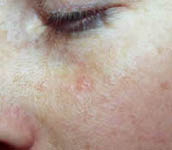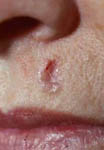Basal cell carcinoma accounts for about 80% of all skin cancers. This type of tumor usually develops in sun-exposed areas, especially the face, neck and ears. Once considered a disease of the elderly, basal cell carcinoma is now frequently seen in younger people. The rise among young people is primarily due to a lifestyle shift towards outdoor activity and increased sun exposure.

Basal cell carcinoma is slow growing and does not usually spread to distant parts of the body. If left untreated, however, basal cell cancer can spread to nearby areas and invade the tissues beneath the skin.
Warning signs for basal cell carcinoma include a new shiny pink bump or a persistent red patch. They can also appear as sores that ooze, bleed and won’t go away. Skin growths that fit these characteristics are highly suspicious. When a physician suspects basal cell carcinoma, a skin biopsy is required to confirm the diagnosis. After confirmation, treatment will vary based on location and tumor subtype. Aggressive tumors, recurrent tumors, or tumors on cosmetically important locations like the nose, lip, or ear are usually surgically removed with a specialized technique called Mohs surgery. Tumors in other locations can often be treated with standard surgical removal.
Following treatment, yearly follow-up is necessary for people who have had basal cell carcinoma because one-third of patients will develop a new tumor within three to five years.
Learn more about basal cell carcinoma from:


